Related projects & activities

Tipping points in ecosystem structure, function and services
We investigated how marine ecosystems respond to change, and identified tipping points, risks and ways of managing them.
MoreThis project has produced or contributed to
